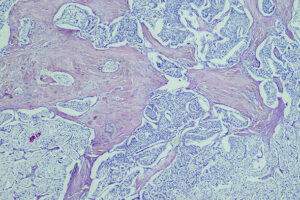Oncology
Gastroenteropancreatic Neuroendocrine Tumors
Gastroenteropancreatic Neuroendocrine Tumors: Clinical Trials and Future Directions
The session “NET Year in Review” at the North American Neuroendocrine Tumor Society (NANETS) 2023 Multidisciplinary NET Medical Symposium highlighted key clinical trials that are likely to shape the future of advanced neuroendocrine tumor (NET) treatment.
Following this session, featured expert Thorvardur R. Halfdanarson, MD, was interviewed by Conference Reporter Editor-in-Chief Tom Iarocci, MD. Dr Halfdanarson’s clinical perspectives on these findings are presented here.
It has been really nice to see an increase in the number of prospective and randomized clinical trials in NETs. For practitioners who are treating patients with NETs, I would strongly encourage the consideration of clinical trials that might be suitable for your patients. I know that it is not always feasible, but the only way that we can continue to move this field forward is to encourage even greater participation in the clinical trial process.
In “NET Year in Review” at the NANETS 2023 Multidisciplinary NET Medical Symposium, we noted the results of the phase 2 randomized ECOG-ACRIN Cancer Research Group E2211 trial, which evaluated the use of capecitabine plus temozolomide vs temozolomide alone in patients with advanced pancreatic NETs. The primary end point of the study was progression-free survival (PFS), and this was positive in the capecitabine-plus-temozolomide group, which demonstrated a longer PFS than the temozolomide-alone group at the interim analysis. There definitely seems to be an added benefit of capecitabine with a relatively minimal increase in toxicities. An interesting secondary analysis looking at the predictive value of methylguanine methyltransferase (MGMT) found that an MGMT deficiency was associated with a response. Although an association of MGMT deficiency with response was observed, MGMT testing is not yet recommended as a routine test but could be considered under certain circumstances. It is also worth noting that the median overall survival in the final analysis was more than 53 months in both groups. That is not a short amount of time for patients who have previously received other treatments. Recent retrospective studies of patients with advanced gastroenteropancreatic NETs (GEP-NETs) have shown overall survival exceeding 10 years in patients with metastatic disease following progression on first-line somatostatin analogue (SSA) therapy.
With regard to treatment sequencing, most of us will agree that octreotide or lanreotide is, in general, a very reasonable first-line therapy for patients with somatostatin receptor (SSTR)–expressing, grade 1 or grade 2 (or even some grade 3), well-differentiated pancreatic NETs, unless, for example, you are dealing with the symptoms of tumor bulk, in which case you would want to use something to shrink the tumors. But beyond SSA therapy, we have several effective options, and we would like to better understand their optimal use. These options include peptide receptor radionuclide therapy (PRRT), capecitabine plus temozolomide, everolimus, sunitinib, and, most recently, cabozantinib, but the Alliance CABINET trial, results of which were presented at the European Society for Medical Oncology Congress 2023 following this year’s NANETS symposium, confirmed the efficacy of cabozantinib in previously treated GEP-NETs.
One of the most important studies that is being done in this space is the currently recruiting, phase 2 Alliance A022001 trial (ComPareNET), which is comparing PRRT with capecitabine plus temozolomide in patients who have unresectable tumors or metastatic disease; prior treatment with SSA therapy, as well as prior use of tyrosine kinase inhibitors such as mTOR inhibitors (eg, everolimus) or VEGF pathway inhibitors (eg, sunitinib or cabozantinib), is allowed per the investigational protocol. The phase 2 OCLURANDOM study comparing PRRT vs sunitinib in patients with pancreatic NETs was presented last year at the European Society for Medical Oncology Congress. There was clear evidence in favor of PRRT in that cohort, but that is not too surprising because sunitinib has limited efficacy in the management of pancreatic NETs.
We are also beginning to consider whether moving PRRT up in the treatment paradigm might improve outcomes in certain groups of patients with GEP-NETs. Specifically, these are patients with SSTR-expressing, well-differentiated, grade 3 GEP-NETs, as well as grade 2 GEP-NETs that are at the higher end of the Ki-67 spectrum for grade 2. Two prospective, randomized, phase 3 trials (ie, NETTER-2 and COMPOSE) both explore the earlier incorporation of PRRT in these patients, although there are some differences in design between the trials.
The NETTER-2 trial evaluates first-line lutetium Lu 177 dotatate (177Lu-dotatate) plus long-acting octreotide vs high-dose, long-acting octreotide. The primary end point is PFS, and there was a recent announcement indicating that this was met, so we await further reporting from that trial. The COMPOSE trial is still ongoing and is looking at a slightly different PRRT (ie, 177Lu-edotreotide) for up to 6 cycles as first- or second-line treatment. Whereas NETTER-2 incorporated PRRT strictly as a part of the first-line therapy, COMPOSE explores PRRT as a first- or second-line treatment. The results of these trials are eagerly awaited, and I am hoping that we will see the NETTER-2 results in 2024. COMPOSE is still accruing and is therefore unlikely to yield results for another 1 to 2 years.
In patients who have previously received PRRT, we are also asking questions to determine the role of PRRT retreatment. At the NANETS 2023 Multidisciplinary NET Medical Symposium, Hope et al presented data from the ACTION-1 study, a large, randomized, phase 1b/3 trial evaluating the alpha particle emitter actinium-225 (225Ac)–dotatate in patients with SSTR-positive, well-differentiated GEP-NETs who previously received 2 to 4 cycles of 177Lu-SSA therapy (abstract T-1). Alpha particles deliver a much higher energy to tumor cells and have a much shorter path length than beta particles such as lutetium-177, potentially resulting in more DNA damage and tumor killing, as well as, theoretically, less toxicity. ACTION-1 is randomizing patients to 225Ac-dotatate PRRT for up to 4 cycles or physician’s choice of everolimus, sunitinib, or high-dose octreotide or lanreotide. This is a very important study because we have seen that PRRT is very effective after progression on SSAs, but the data on PRRT retreatment thus far have mostly been retrospective.
Another study evaluating PRRT retreatment is the NET RETREAT trial (abstract T-11). This study, which was also presented at this year’s NANETS symposium, is comparing retreatment with 177Lu-dotatate vs everolimus in patients with metastatic, unresectable midgut NETs. The inclusion criteria are slightly different in ACTION-1 and NET RETREAT; ACTION-1 is allowing patients to enroll as long as they have not progressed within 6 months of the last lutetium, while NET RETREAT is requiring stable disease for 12 months.
These were only some of the highlights that we considered at the NANETS 2023 Multidisciplinary NET Medical Symposium, and it was wonderful to see all the progress. The epidemiology is such that we will have more patients with NETs living longer who need more medical attention, and these patients need better therapies. In fact, according to some sources, NETs are now the tenth most prevalent malignancy in England and the second most prevalent gastrointestinal malignancy after colorectal cancer. And, as we bring more effective therapies to the clinic that prolong patient survival, the prevalence will likely increase even further. So, there is also much more work to be done, and even more resources need to be allocated to NET care and research.
Baudin E, Walter TA, Beron A, et al. First multicentric randomized phase II trial investigating the antitumor efficacy of peptide receptor radionucleide therapy with 177lutetium-octreotate (OCLU) in unresectable progressive neuroendocrine pancreatic tumor: results of the OCLURANDOM trial [abstract 8870]. Abstract presented at: European Society for Medical Oncology Congress 2022; September 9-13, 2022; Paris, France.
Chan J, Geyer S, Ou F, et al. Alliance A021602: phase III, double-blinded study of cabozantinib versus placebo for advanced neuroendocrine tumors (NET) after progression on prior therapy (CABINET) [abstract LBA53]. Abstract presented at: European Society for Medical Oncology Congress 2023; October 20-24, 2023; Madrid, Spain.
Chauhan A, O’Callaghan C, Myrehaug S, et al. NET RETREAT: a phase II study of 177lutetium-dotatate retreatment vs. everolimus in metastatic/unresectable midgut NET [abstract T-11]. Abstract presented at: North American Neuroendocrine Tumor Society 2023 Multidisciplinary NET Medical Symposium; October 4-6, 2023; Montreal, Quebec.
ClinicalTrials.gov. Comparing capecitabine and temozolomide in combination to lutetium Lu 177 dotatate in patients with advanced pancreatic neuroendocrine tumors. Updated November 1, 2023. Accessed November 15, 2023. https://clinicaltrials.gov/study/NCT05247905
ClinicalTrials.gov. Study to evaluate the efficacy and safety of Lutathera in patients with grade 2 and grade 3 advanced GEP-NET (NETTER-2). Updated October 24, 2023. Accessed November 15, 2023. https://clinicaltrials.gov/study/NCT03972488
Halfdanarson TR. NET year in review. Session presented at: North American Neuroendocrine Tumor Society 2023 Multidisciplinary NET Medical Symposium; October 4-6, 2023; Montreal, Quebec.
Halfdanarson TR, Reidy DL, Vijayvergia N, et al. Pivotal phase III COMPOSE trial will compare 177Lu-edotreotide with best standard of care for well-differentiated aggressive grade 2 and grade 3 gastroenteropancreatic neuroendocrine tumors [abstract TPS514]. Abstract presented at: 2022 American Society of Clinical Oncology Annual Meeting; June 3-7, 2022; Chicago, IL.
Hope TA, Halperin D, Strosberg J, Jacene H, et al. ACTION-1: A randomized phase Ib/3 trial of RYZ101 compared with SoC in SSTR+ well-differentiated GEP-NET with progression following Lu-177 SSA [abstract T-1]. Abstract presented at: North American Neuroendocrine Tumor Society 2023 Multidisciplinary NET Medical Symposium; October 4-6, 2023; Montreal, Quebec.
Kunz PL, Graham NT, Catalano PJ, et al. Randomized study of temozolomide or temozolomide and capecitabine in patients with advanced pancreatic neuroendocrine tumors (ECOG-ACRIN E2211). J Clin Oncol. 2023;41(7):1359-1369. doi:10.1200/JCO.22.01013
Pusceddu S, Prinzi N, Tafuto S, et al. Association of upfront peptide receptor radionuclide therapy with progression-free survival among patients with enteropancreatic neuroendocrine tumors. JAMA Netw Open. 2022;5(2):e220290. doi:10.1001/jamanetworkopen.2022.0290
Riechelmann RP, Taboada RG, de Jesus VHF, Iglesia M, Trikalinos NA. Therapy sequencing in patients with advanced neuroendocrine neoplasms. Am Soc Clin Oncol Educ Book. 2023;43:e389278. doi:10.1200/EDBK_389278
White BE, Rous B, Chandrakumaran K, et al. Incidence and survival of neuroendocrine neoplasia in England 1995-2018: a retrospective, population-based study. Lancet Reg Health Eur. 2022;23:100510. doi:10.1016/j.lanepe.2022.100510
This information is brought to you by Engage Health Media and is not sponsored, endorsed, or accredited by the North American Neuroendocrine Tumor Society.










